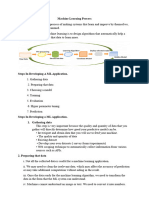Introduction To Machine Learning
Uploaded by
acmeIntroduction To Machine Learning
Uploaded by
acmeMachine learning involves a sequence of steps or a workflow that generally looks like this:
1. Data Collection: The process begins with gathering relevant data that the algorithm will learn
from. This data can come from various sources like databases, sensors, or APIs.
2. Data Preprocessing: This step involves cleaning the data by removing any noise, handling
missing values, normalizing or scaling features, and transforming the data into a suitable format
for the algorithms.
3. Feature Engineering: This is where domain knowledge comes into play. Engineers select or
create the most relevant features (variables) that will help the model learn effectively. This step
can greatly impact the model's performance.
4. Model Selection: Choosing the appropriate machine learning algorithm or model that fits the
problem at hand. This could be decision trees, neural networks, support vector machines, etc.,
depending on the nature of the data and the problem.
5. Model Training: Using the selected algorithm, the model is trained on the prepared data. During
training, the model learns the patterns and relationships present in the data.
6. Model Evaluation: Once trained, the model needs to be evaluated to assess its performance.
This involves using a separate set of data (validation or test data) to measure how well the
model generalizes to new, unseen data.
7. Model Tuning: Fine-tuning the model by adjusting hyperparameters or making modifications to
improve its performance. This process involves iteration and experimentation.
8. Deployment: After a satisfactory model is achieved, it's deployed into a production environment
where it can be used to make predictions or decisions on new, real-world data.
Here's a simplified flowchart representation:
Data Collection -> Data Preprocessing -> Feature Engineering -> Model Selection -> Model Training ->
Model Evaluation -> Model Tuning -> Deployment
This flow isn't strictly linear; it often involves iterations and loops, as improvements in one step may
require revisiting previous stages to enhance the model's performance further. Each step is crucial for
the success of the machine learning process, and the iterative nature allows for constant refinement and
improvement.
You might also like
- Machine Learning Steps - A Complete Guide - SimplilearnNo ratings yetMachine Learning Steps - A Complete Guide - Simplilearn11 pages
- Machine Learning And Deep Learning With Python A Beginners Guide To Programming - 2 Books In 1No ratings yetMachine Learning And Deep Learning With Python A Beginners Guide To Programming - 2 Books In 1132 pages
- Flow Diagram of Machine Learning or Life Cycle of Machine LearningNo ratings yetFlow Diagram of Machine Learning or Life Cycle of Machine Learning91 pages
- DATA MINING AND MACHINE LEARNING. PREDICTIVE TECHNIQUES: REGRESSION, GENERALIZED LINEAR MODELS, SUPPORT VECTOR MACHINE AND NEURAL NETWORKSFrom EverandDATA MINING AND MACHINE LEARNING. PREDICTIVE TECHNIQUES: REGRESSION, GENERALIZED LINEAR MODELS, SUPPORT VECTOR MACHINE AND NEURAL NETWORKSNo ratings yet
- Class Notes: The Basics of Machine LearningNo ratings yetClass Notes: The Basics of Machine Learning4 pages
- In Depth Explanation of Machine Learning ConceptsNo ratings yetIn Depth Explanation of Machine Learning Concepts3 pages
- A Practical and Technical Introduction To Machine LearningNo ratings yetA Practical and Technical Introduction To Machine Learning23 pages
- DATA MINING and MACHINE LEARNING. PREDICTIVE TECHNIQUES: ENSEMBLE METHODS, BOOSTING, BAGGING, RANDOM FOREST, DECISION TREES and REGRESSION TREES.: Examples with MATLABFrom EverandDATA MINING and MACHINE LEARNING. PREDICTIVE TECHNIQUES: ENSEMBLE METHODS, BOOSTING, BAGGING, RANDOM FOREST, DECISION TREES and REGRESSION TREES.: Examples with MATLABNo ratings yet
- Drugs Acting on the Peripheral Nervous System ;chapter 2No ratings yetDrugs Acting on the Peripheral Nervous System ;chapter 24 pages
- Introduction To Nomenclature of Organic Chemical Systems With Particular Reference To Heterocyclic Compounds Containing Up To Three RingsNo ratings yetIntroduction To Nomenclature of Organic Chemical Systems With Particular Reference To Heterocyclic Compounds Containing Up To Three Rings5 pages







































































